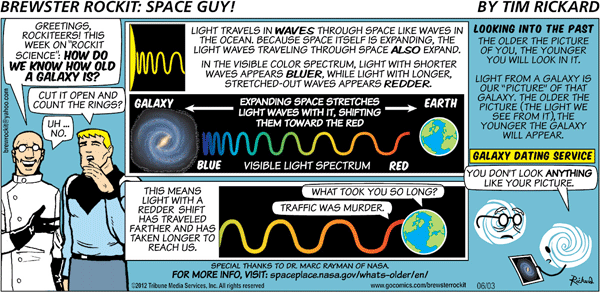
When you hear a siren coming toward you, the perceived frequency is increased. After the source passes you, the perceived frequency gets noticeably lower. This change in frequency based on relative speed is the Doppler shift. The size of the frequency change is related to the speed that the source is moving with respect to the listener.
In a similar manner, when we look at light, the apparent frequency will change based on the relative speed of the light source and the observer. This Doppler shift is calibrated by looking at the absorption lines in the spectra. When we measure the redshift, we are really measuring how far the absorption lines have moved with respect to a reference spectrum.
However, there is another theory that explains the observed redshift - as the universe continues to expand, it stretches the light traveling through it, making it appear redder than what it originally was.
Sunday comics
On Sunday June 3, 2012, Brewster Rockit tried to describe how the redshift is used to determine how old a galaxy is.

Expanding space stretches light waves with it, shifting them toward the red |
I think this is important because millions of people read this stuff.
The NASA Reference
Space expanding over time stretches light waves traveling through it |
The following is copied from the NASA page
|
What clues do astronomers use to tell the age of a galaxy? Cosmic time stampLight travels in waves, like energy moves through the ocean in waves. Light waves change as they travel through space and time. That is because space itself is always expanding and stretching the distances between things. So the light waves traveling through this expanding space become themselves expanded. No matter what, light always travels at the same speed in space: 300,000 kilometers (or 186,000 miles) per second (in round numbers). That means it takes some amount of time—a little or a lot—for light to get anywhere. The distance light can travel in one Earth year is called a light year. A light year is very long distance: around 9 trillion kilometers (6 trillion miles). That's a 9 (or a 6) with 12 zeroes after it! Light waves from a very distant galaxy that have been traveling a long, long time (say, billions of years) starts looking very stretched out! Astronomers say that the light is red-shifted, because red light has the longest, most "stretched out" waves of all the colors of the light we can see with our eyes.  |
The NASA Source
I realize that there may be more than one "Dr. Marc Rayman" with NASA, but the most likely candidate a Propulsion Engineer at JPL and is referred to as Dr. Marc at spaceplace.nasa.gov.
Dr. Marc answers questions about space.
New Physics
So I did a bit more research .. apparently, there is new physics since I went to school.
In 1937, Edwin Hubble wrote.
|
"[If the redshifts are a Doppler shift] … the observations as they stand lead to the anomaly of a closed universe, curiously small and dense, and, it may be added, suspiciously young. On the other hand, if redshifts are not Doppler effects, these anomalies disappear and the region observed appears as a small, homogeneous, but insignificant portion of a universe extended indefinitely both in space and time."
— E. Hubble, Monthly Notices of the Royal Astronomical Society, 97, 513, 1937 |
According to Wikipedia, some of the observed redshifts were so high that the objects were moving faster than the speed of light. Since we "know" that that is impossible, the physics was modified so that
| In the widely accepted cosmological model based on general relativity, redshift is mainly a result of the expansion of space: this means that the farther away a galaxy is from us, the more the space has expanded in the time since the light left that galaxy, so the more the light has been stretched, the more redshifted the light is, and so the faster it appears to be moving away from us. |
| "Light leaves a galaxy, which is stationary in its local region of space, and is eventually received by observers who are stationary in their own local region of space. Between the galaxy and the observer, light travels through vast regions of expanding space. As a result, all wavelengths of the light are stretched by the expansion of space. It is as simple as that.... ref - Edward Robert Harrison, Cosmology: The Science of the Universe, 2000, p315 |
So .. who would have believed it. I learned something new from the Sunday funnies!
On the other hand, I am bothered by the idea that a photon (basically, a particle with wave properties) can be changed by a change in space itself.
Author: Robert Clemenzi